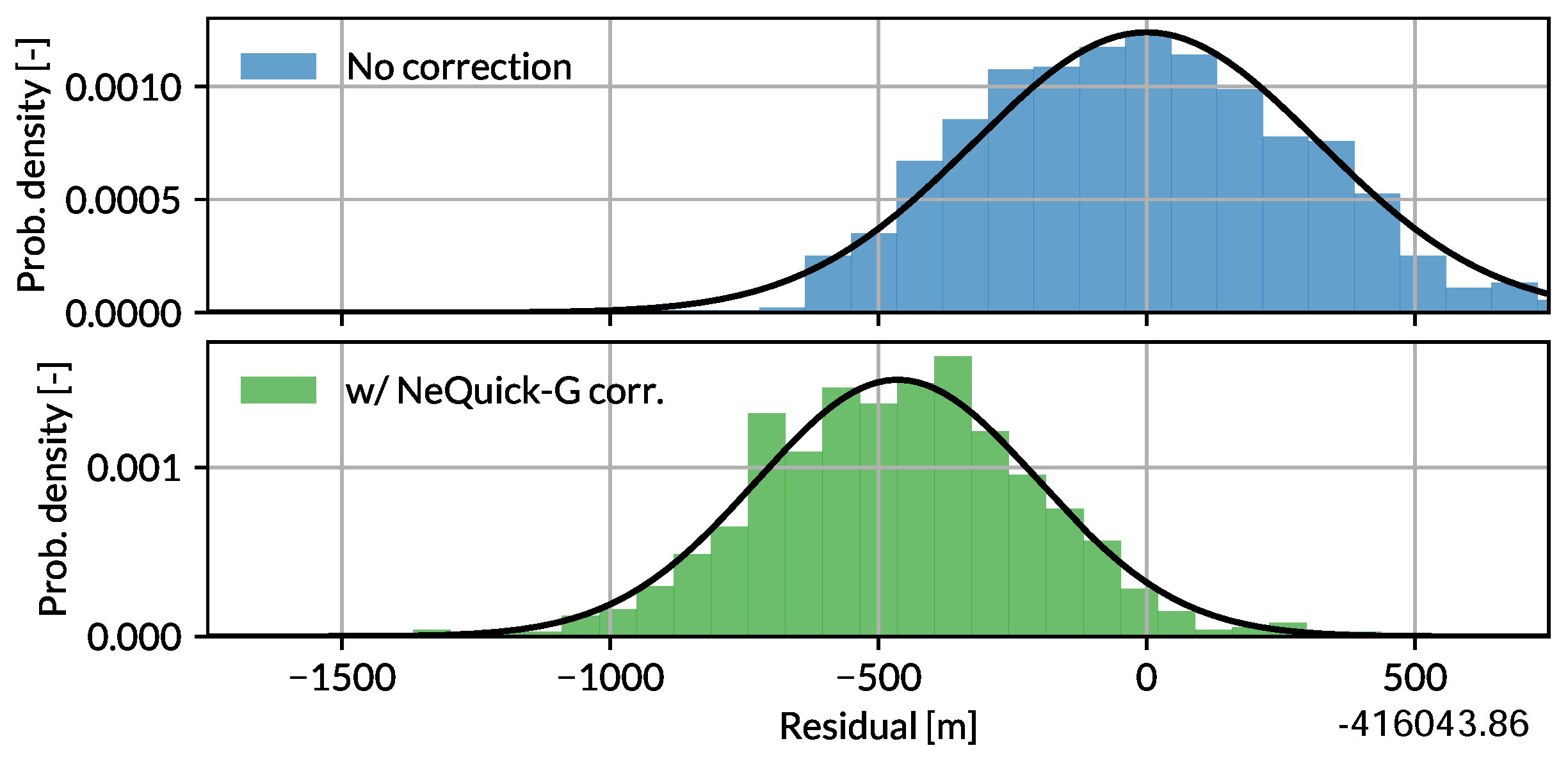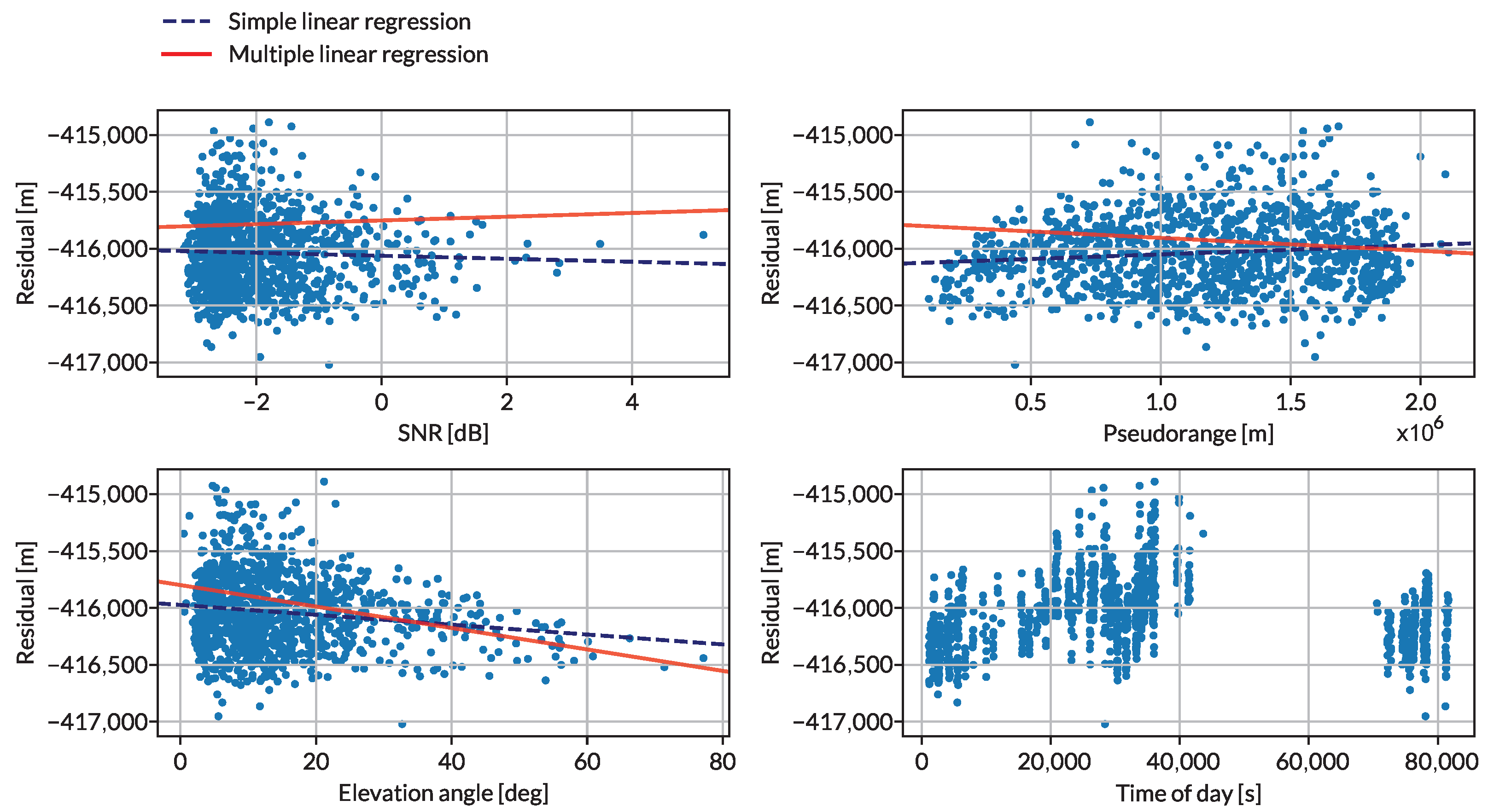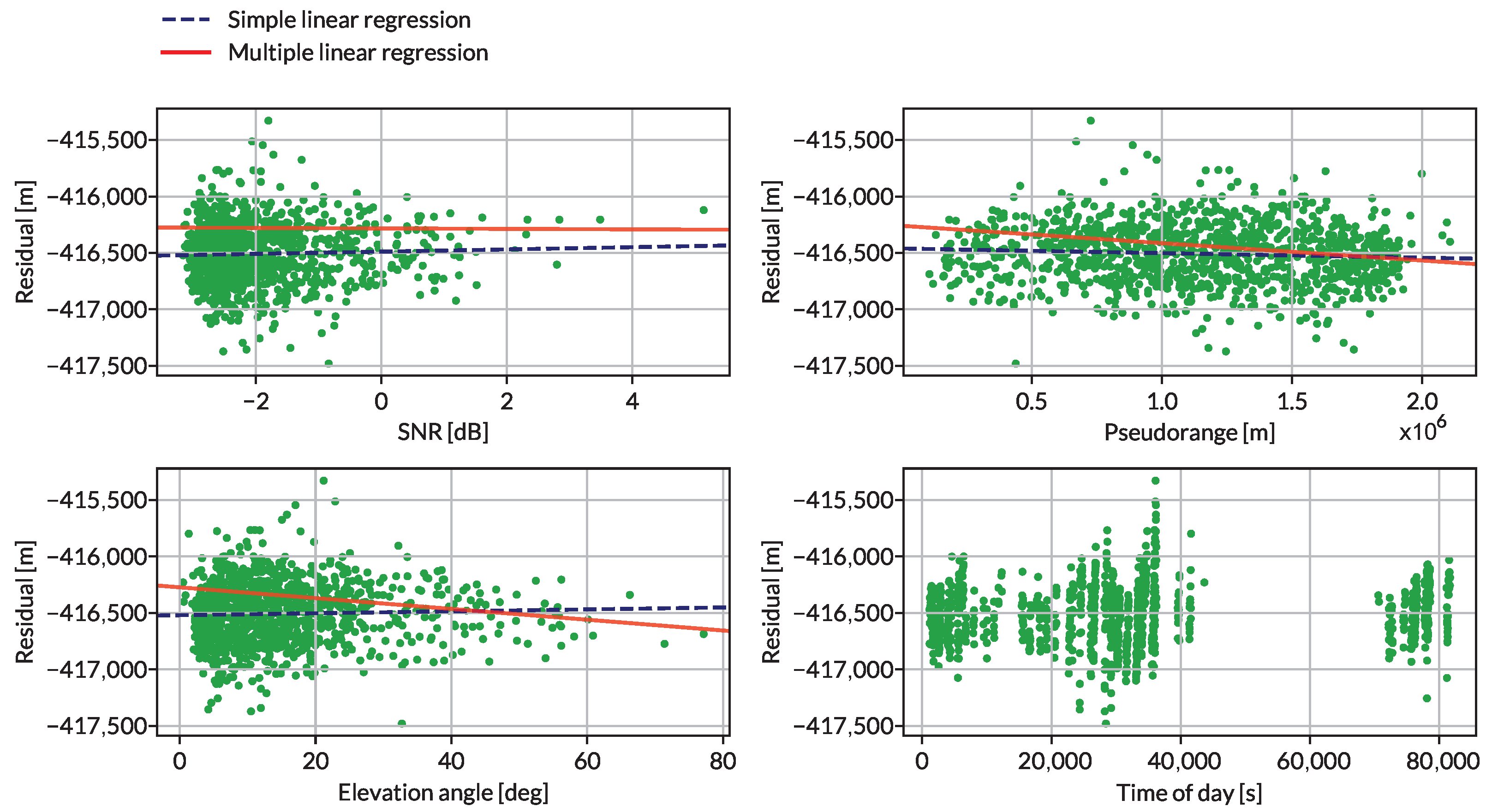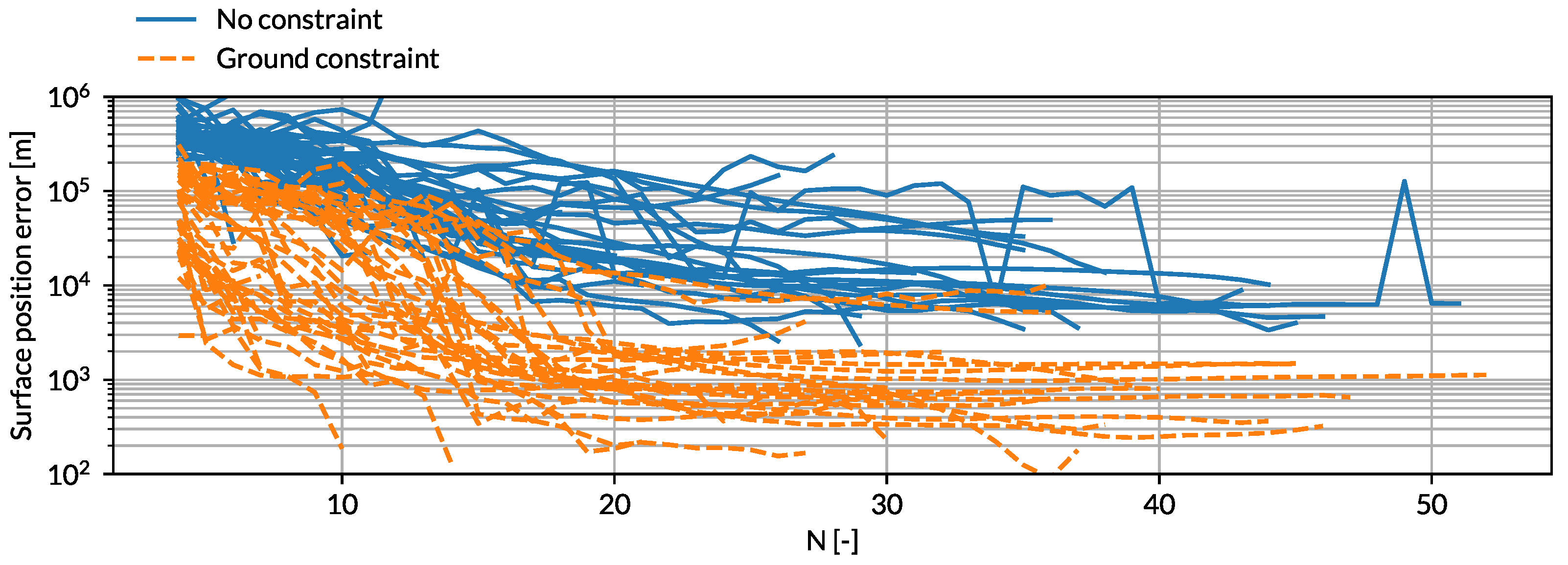Characteristics of Experimental VDE-SAT Ranging Signals and System Performance Analysis for Critical Navigation †
Abstract
1. Introduction
2. Data Description
2.1. Testing Infrastructure
2.2. Measurements and Auxiliary Data
3. Methodology
3.1. Signal Characteristics
3.1.1. Residual Pseudorange Analysis
3.1.2. Parametric Analysis
3.1.3. Ionospheric Signal Corrections
3.2. Positioning Performance Analysis Method
4. Results
4.1. Signal Characteristics
4.2. Autonomous VDE-SAT Positioning Performance
5. Discussion and Conclusions
Author Contributions
Funding
Institutional Review Board Statement
Informed Consent Statement
Data Availability Statement
Acknowledgments
Conflicts of Interest
References
- Kraftig øKning av GPS-Jamming over FINNMARK. Available online: https://www.nrk.no/tromsogfinnmark/kraftig-okning-av-gps-jamming-over-finnmark-1.16309499 (accessed on 3 October 2023).
- Mangedobling av GPS-Jamming Mot Norge. Available online: https://www.nrk.no/tromsogfinnmark/mangedobling-av-gps-jamming-mot-norge-1.16563000 (accessed on 3 October 2023).
- Ambulansefly Kunne Ikke Lande Etter GPS-Utfall. Available online: https://www.tv2.no/nyheter/innenriks/ambulansefly-kunne-ikke-lande-etter-gps-utfall/10397144/ (accessed on 3 October 2023).
- Johnson, G.; Swaszek, P. The Feasibility of R-Mode to Meet Resilient PNT Requirements for e-Navigation. In Proceedings of the 27th International Technical Meeting of the Satellite Division of the Institute of Navigation, ION GNSS 2014, Tampa, FL, USA, 8–12 September 2014. [Google Scholar]
- Šafář, J.; Grant, A.; Williams, P.; Ward, N. Performance Bounds for VDES R-mode. J. Navig. 2020, 73, 92–114. [Google Scholar] [CrossRef]
- Šafář, J.; Shaw, G.; Grant, A.; Haugli, H.C.; Løge, L.; Christiansen, S.E.; Alagha, N. GNSS Augmentation Using the VHF Data Exchange System (VDES). In Proceedings of the 31st International Technical Meeting of The Satellite Division of the Institute of Navigation (ION GNSS+ 2018), Miami, FL, USA, 24–28 September 2018; pp. 1788–1805. [Google Scholar]
- Šafář, J.; Grant, A.; Bransby, M. Performance Bounds for VDE-SAT R-Mode. Int. J. Satell. Commun. Netw. 2021, 41, 134–157. [Google Scholar] [CrossRef]
- Wirsing, M.; Dammann, A.; Raulefs, R. VDES R-Mode Performance Analysis and Experimental Results. Int. J. Satell. Commun. Netw. 2023, 41, 158–177. [Google Scholar] [CrossRef]
- Owens, A.J.; Richardson, T.; Critchley-Marrows, J. The Feasibility of a VDE-SAT Ranging Service as an Augmentation to GNSS for Maritime Applications. In Proceedings of the 34th International Technical Meeting of the Satellite Division of The Institute of Navigation (ION GNSS+ 2021), St. Louis, MO, USA, 20–24 September 2021; pp. 591–616. [Google Scholar]
- ITU-R. Recommendation ITU-R M.2092-1: Technical Characteristics for a VHF Data Exchange System in the VHF Maritime Mobile Band; Geneva, Switzerland, 2022. [Google Scholar]
- World Geodetic System 1984 (WGS 84). Available online: https://earth-info.nga.mil/?dir=wgs84&action=wgs84 (accessed on 6 October 2023).
- Milliken, R.J.; Zoller, C.J. Principle of Operation of NAVSTAR and System Characteristics. Navigation 1978, 25, 95–106. [Google Scholar] [CrossRef]
- Thompson, W.R. On a Criterion for the Rejection of Observations and the Distribution of the Ratio of Deviation to Sample Standard Deviation. Ann. Math. Stat. 1935, 6, 214–219. [Google Scholar] [CrossRef]
- Stephens, M.A. EDF Statistics for Goodness of Fit and Some Comparisons. J. Am. Stat. Assoc. 1974, 69, 730–737. [Google Scholar] [CrossRef]
- Anderson, T.W.; Darling, D.A. Asymptotic Theory of Certain “Goodness of Fit” Criteria Based on Stochastic Processes. Ann. Math. Stat. 1952, 23, 193–212. [Google Scholar] [CrossRef]
- Breivik, K.; Forssell, B.; Kee, C.; Enge, P.; Walter, T. Estimation of Multipath Error in GPS Pseudorange Measurements. Navigation 1997, 44, 43–52. [Google Scholar] [CrossRef]
- Klobuchar, J. Ionospheric Time-Delay Algorithm for Single-Frequency GPS Users. IEEE Trans. Aerosp. Electron. Syst. 1987, AES-23, 325–331. [Google Scholar] [CrossRef]
- European Commission. Ionospheric Correction Algorithm for GALILEO Single Frequency Users. 2016. Available online: https://www.gsc-europa.eu/sites/default/files/sites/all/files/Galileo_Ionospheric_Model.pdf (accessed on 18 May 2025).
- Moré, J.J. The Levenberg-Marquardt Algorithm: Implementation and Theory. In Numerical Analysis; Watson, G.A., Ed.; Springer: Berlin/Heidelberg, Germany, 1978; Volume 630, pp. 105–116. [Google Scholar] [CrossRef]
- Bullock, R. Great Circle Distances and Bearings between Two Locations. MDT. 2007. Available online: https://dtcenter.org/sites/default/files/community-code/met/docs/write-ups/gc_simple.pdf (accessed on 18 May 2025).
- Hu, W.; Farrell, J.A. Technical Note: Derivation of Earth-Rotation Correction (Sagnac) and Analysis of the Effect of Receiver Clock Bias; Technical Note; UC Riverside: Riverside, CA, USA, 2019. [Google Scholar]
- IALA. R0129 Gnss Vulnerability and Mitigation Measures, Edition 3.1. 2012. Available online: https://www.iala.int/product/r0129/ (accessed on 18 May 2025).




| Pos. Element | Value |
|---|---|
| (Latitude, Longitude, Height) | (, , ) |
| (, , ) |
Disclaimer/Publisher’s Note: The statements, opinions and data contained in all publications are solely those of the individual author(s) and contributor(s) and not of MDPI and/or the editor(s). MDPI and/or the editor(s) disclaim responsibility for any injury to people or property resulting from any ideas, methods, instructions or products referred to in the content. |
© 2025 by the authors. Licensee MDPI, Basel, Switzerland. This article is an open access article distributed under the terms and conditions of the Creative Commons Attribution (CC BY) license (https://creativecommons.org/licenses/by/4.0/).
Share and Cite
Pettersen, Ø.B.; van den IJssel, J.; Rasmussen, S.-I. Characteristics of Experimental VDE-SAT Ranging Signals and System Performance Analysis for Critical Navigation. Eng. Proc. 2025, 88, 60. https://doi.org/10.3390/engproc2025088060
Pettersen ØB, van den IJssel J, Rasmussen S-I. Characteristics of Experimental VDE-SAT Ranging Signals and System Performance Analysis for Critical Navigation. Engineering Proceedings. 2025; 88(1):60. https://doi.org/10.3390/engproc2025088060
Chicago/Turabian StylePettersen, Øyvind Bryhn, Jose van den IJssel, and Sven-Ingve Rasmussen. 2025. "Characteristics of Experimental VDE-SAT Ranging Signals and System Performance Analysis for Critical Navigation" Engineering Proceedings 88, no. 1: 60. https://doi.org/10.3390/engproc2025088060
APA StylePettersen, Ø. B., van den IJssel, J., & Rasmussen, S.-I. (2025). Characteristics of Experimental VDE-SAT Ranging Signals and System Performance Analysis for Critical Navigation. Engineering Proceedings, 88(1), 60. https://doi.org/10.3390/engproc2025088060





